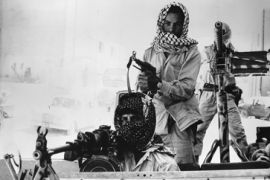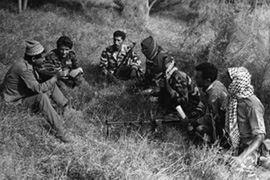
Empowering the powerless
Middle East analyst says armed struggle put Palestinian resistance on the world map.
 |
| In 1948 many refugees flocked to Jordan, which would later be a base for the PLO [GALLO/GETTY] |
PLO: History of a Revolution is a six-part series that tells the turbulent story of the Palestinian struggle for a national home.
In the following account, Al Jazeera’s senior Middle East analyst explains the origins of the Palestinian armed struggle.
Israeli writers and politicians, including Shimon Peres, the Israeli president, have repeatedly lamented the absence of a Palestinian Nelson Mandela.
It is not that Israeli leaders are hoping for the emergence of a nationalist Palestinian hero, but rather that they are implicitly condemning the Palestinians for resorting to armed struggle to attain their freedom.
While it is legitimate to debate whether the Palestinians could have achieved more by confining themselves to non-violent means, this should not be used as an excuse by the Israeli occupiers to justify their continued denial of Palestinian national rights.
Historical context
The Palestinian armed struggle must be placed in its proper historical context if it is to be fully understood.
Initially formed by Arab states in 1964 to contain Palestinian activism, the Palestine Liberation Organisation (PLO) did not evolve into a legitimate representative of the Palestinian people until clandestine armed factions led by Fatah assumed its leadership.
The first spark of the armed struggle was a modest and ineffective operation in the north of the West Bank on New Year’s Eve 1965, when Fatah tried to sabotage an Israeli national water carrier.
 |
| Palestinian guerrillas discuss tactics in Lebanon in 1969 [GALLO/GETTY] |
Although foiled by the Israelis, this operation signalled the birth of the post-1948 Palestinian armed resistance.
Fatah had been established seven years earlier in 1958, but the decision to announce their existence through a “military operation” was deliberate.
It was not about the success or scope of the attack, but a declaration that Palestinians had rejected submission and started their own liberation movement.
The group’s earlier years had been focused on mobilising and unifying Palestinians around the goal of liberation.
Through Felastenouna (Our Palestine) magazine, Fatah’s leaders had encouraged Palestinians to write their stories of disposition with the aim of raising awareness of Palestinian rights and preserving collective memory and national identity.
Khalil al-Wazir, who took on the nom de guerre Abu Jihad and became the mastermind of the armed struggle, ran the magazine and used it to recruit people to the new movement.
Spirit of the times
Fatah’s young co-founders, led by Yasser Arafat, were not operating in a vacuum but were inspired by the spirit of armed revolutions and national liberation movements taking place elsewhere.
They were emulating the Algerian liberation revolution and were influenced by the works of Mao Zedong on guerrilla warfare, and the tactics of the Vietnamese general, Vo Nguyen Giap.
But they understood that guerrilla warfare was impossible without a front line sanctuary – a launching pad for their attacks.
Palestinians who had remained in their homes after the establishment of Israel were subjected to repressive military laws. Those in the Gaza Strip and West Bank were under Egyptian and Jordanian rule, respectively.
While Gamal Abdel Nasser, the Egyptian president, supported the idea of armed resistance, the Fatah leaders knew that they would not be allowed to use Gaza as a base for military attacks.
The Jordanian Hashemites were bound by a tacit understanding between the late King Abdullah and the founders of Israel that any activities that could challenge Israel were strictly prohibited in the West Bank or even the East Bank of the kingdom.
In conversations I had with Khalil al-Wazir in the 1980s – before he was assassinated by Israel in 1988 – he repeatedly stressed that they were aware that an armed Palestinian movement would not “liberate Palestine” on its own but could “drag Arab governments into action against Israel”.
But it was mostly the bitter memory of their forced expulsion that haunted the Fatah leaders. They were determined to never again feel defenceless, wait for Arab armies to protect them, or have Arab leaders to speak on their behalf.
Forming an armed resistance movement was an act of empowerment for those who felt powerless as the world watched them become stateless refugees.
Filling the void
The concept of armed struggle did not take centre stage until after the devastating defeat of Arab armies in the 1967 war. The front line states, from revolutionary Egypt to the pro-Western Jordanian monarchy, were left politically exposed and struggled to regain legitimacy.
| IN DEPTH | |||||||||||
|
Their defeat left a void and the Palestinian armed movement stepped into that vacuum, assuming a leadership role that was far beyond its size and capabilities.
Its military defeat had loosened the Jordanian state’s grip on its national security apparatus and the Palestinians found the armed sanctuary in a front line country they had long sought.
With the majority of its citizens of Palestinian descent and strong pan-Arab nationalist and leftist opposition parties, Jordan provided the sea of support that Mao Zedong had argued was necessary for a guerrilla movement to survive and flourish.
The Palestinian armed presence in Jordan did not enable the movement to launch the sort of guerrilla warfare that would pose a real threat to Israel.
However, it did provide it with a high-profile public existence that enhanced its role as the representative of the Palestinian people.
And it was the Israeli army’s attempt to crush the PLO in the Jordanian border town of Karameh in 1968 that secured the credentials of Palestinian armed groups as a legitimate resistance movement.
Palestinian fighters, with help from Jordanian army officers and soldiers, repelled the better-equipped Israeli attack.
Dignity
The battle of Karameh, which in Arabic means ‘dignity’, ordained the Palestinian resistance movement as the response to the failure of Arab states to deter Israel.
Humiliated by the 1967 defeat, the Arabs – not only Palestinians – embraced the rapidly growing armed resistance. It restored some lost dignity and gave a potent voice not only to Palestinian rights but to an Arab yearning to stand tall and reject defeat.
The late 1960s – with the rise of the Left and the movement against the war in Vietnam – provided a nurturing environment for the Palestinian armed resistance and it soon became the cause célèbre for activists around the world.
Arms from the Eastern bloc started to flow in, as the image of an oppressed people taking their fate into their own hands brought foreign, mostly Western, activists into the ranks of the Palestinian resistance.
By espousing armed struggle and exposing the impotence of Arab states, the Palestinian groups had achieved their first strategic goal: enabling Palestinians to speak for themselves on their own terms.
It was a turning point that placed the Palestinians and their cause on the world map – in their own voice.
Lamis Andoni is Al Jazeera’s senior Middle East analyst.
The views expressed in the above column are the author’s own and do not necessarily reflect those of Al Jazeera.
PLO: History of a Revolution can be seen weekly at the following times GMT: Monday: 0530, 1130; Tuesday: 0130, 1400, 2330; Wednesday: 0630, 1630; Thursday: 0300, 1430; Friday: 0600; Saturday: 1930; Sunday: 1030.
